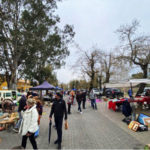The joints make up the skeleton and allow us to move freely. They have, in addition to bones, an sheath called the joint capsule, lined by the synovial membrane which produces synovial fluid. The bones do not normally rub against each other, since they are covered by a firm and elastic cartilage tissue.
In osteoarthritis, the cartilage progressively wears away (degenerates), and the bone tissue below suffers and reacts by forming “more bone” (“overgrowth of defense”, or vulgarly “parrot beaks”) or cysts (small holes), which are observed on radiographies. In addition, the synovial membrane thickens and as more fluid forms, causing some degree of inflammation and swelling. It is a chronic disorder and usually progresses slowly.
There is no treatment that can definitively cure osteoarthritis, but with an appropriate one, symptoms can be alleviated, their evolution slowed down and, in many patients, optimize their quality of life.
It affects both men and women, but in women appears more frequently and with more symptoms. Osteoarthritis is a very common disease and is the most frequent among the joint conditions. To a greater or lesser degree, almost everyone over 70 years of age present it (generally more women), but it should be noted that only one small part of them will have symptoms (pain, stiffness or numbness or loss of joint function). Although it is not exclusive to old age.
It can be developed in one or several joints (generalized), compromising the joints of the fingers, the big toe (“bunion”), the knees, the hips and spine (cervical and lumbar). Osteoarthritis of other joints such as shoulders, elbows, wrists or ankles is infrequent and when it appears, it is a consequence of trauma, misuse, or other disease.
SYMPTOMS: The bone cartilage disease evolves in several phases altering remarkably the function of all the components of the joint. Over time, apart from numbness, it appears pain as the main symptom. A pain that after being in rest, little by little it becomes more tolerated when the movement begins. There may be stiffness contractures, and deformities in advanced cases.
Causes: Aging: The deterioration on a joint and the decreased ability of recovery of the tissues with increasing age condition osteoarthritis to be more frequent in older people. Inheritance or family predisposition. Gender: Female: Higher probability of presenting osteoarthritis in the hands and knees. Male: More frequent development of hip osteoarthritis. Body overweight or obesity: both make it possible for osteoarthritis to progress, especially in load-bearing joints like the hip and knee. Overload that can often come with certain work occupations or sports activities, old fractures, previous surgery of the joint.
TREATMENT: The main goals are to relieve pain and maintain the best possible ability to move.
Pharmacological treatment to relieve pain, whether local, general or intra-articular, includes pain relievers, anti-inflammatories, muscle relaxants or other types of medication that intend to relieve symptoms. There are also other measures such as control of the body weight (balanced diet, with an specific amount of calories depending on the case); joint protection (balancing rest and physical activity), improving postures in daily life, work and during rest; correcting deformities; implementation of various treatment modalities with heat or cold; and a therapeutic exercises plan (for example: to maintain joint movement and strengthen muscle groups).
If you suffer from joint pain, it is very important to consult your doctor, know your diagnosis and start treatment aimed at leading a better quality of life.
For more information visit Gran Alacant Family Doctors
www.familydoctors24h.com or our clinic on Calle Holanda 9, MASA Square, Gran Alacant T: 865 789 554



